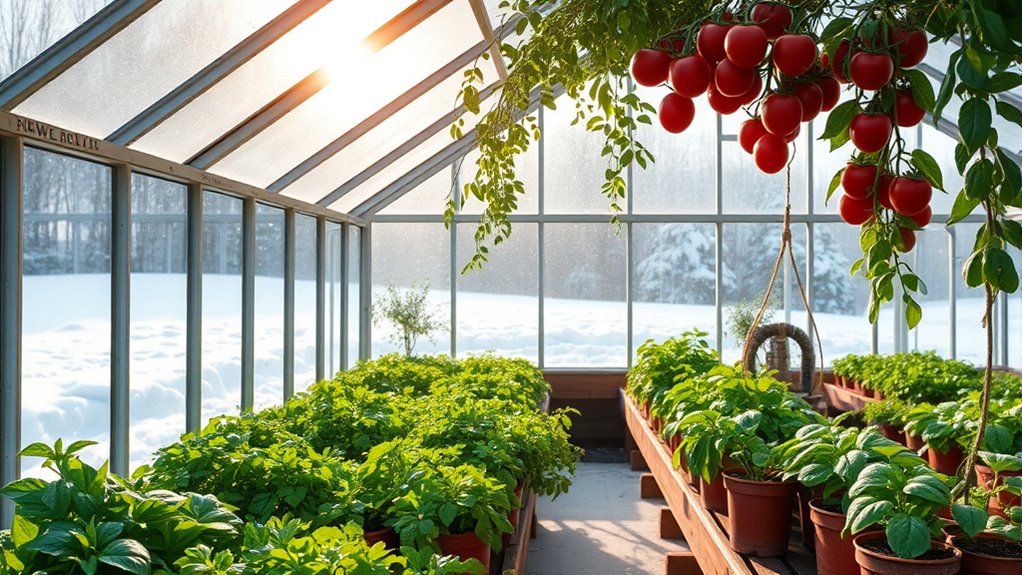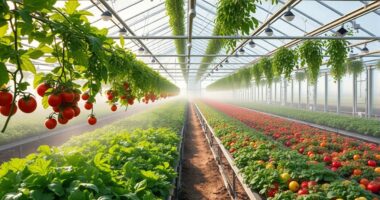Winter greenhouse gardening lets you grow a variety of cold-tolerant crops like leafy greens, root vegetables, and brassicas throughout the winter months. You'll need durable materials and effective heating to create a controlled environment. Focus on maintaining soil quality with organic amendments and proper pH levels. Monitor humidity and temperature, and implement pest management strategies for healthy plants. There's so much more to discover about optimizing your winter garden for success.
Key Takeaways
- Ideal crops for winter greenhouses include cold-tolerant vegetables like kale, spinach, carrots, and microgreens for continuous harvests.
- Prepare soil with a pH of 6.0-7.0, adding organic amendments and ensuring good drainage for healthy plant growth.
- Use durable materials for greenhouse structures and invest in effective heating, ventilation, and energy-efficient grow lights.
- Implement pest management strategies like regular monitoring, introducing beneficial insects, and maintaining a clean environment.
- Regularly harvest crops to encourage regrowth and utilize winter produce in hearty meals or preserve excess for later use.
Benefits of Winter Greenhouse Gardening
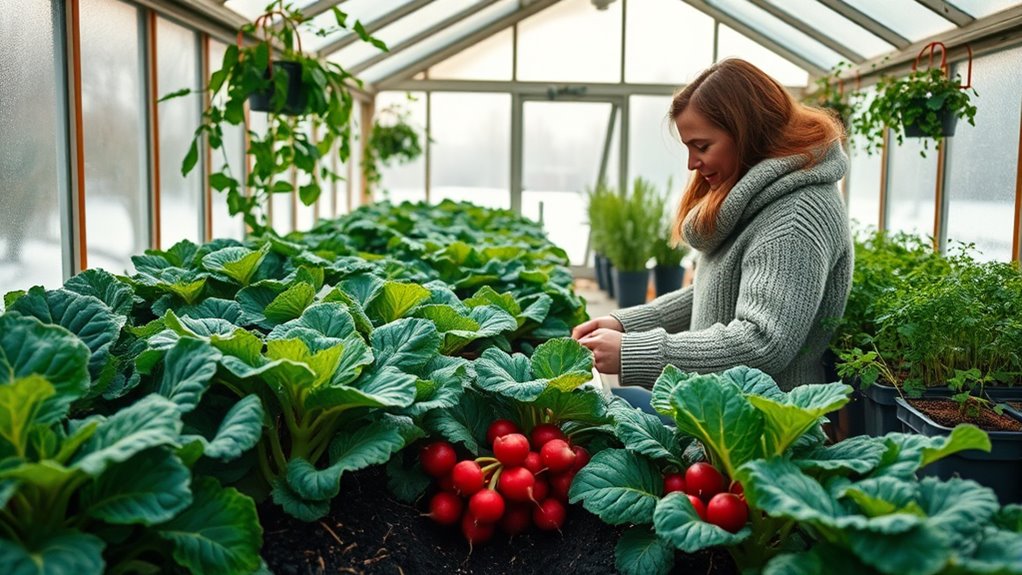
When you embrace winter greenhouse gardening, you unlock a world of benefits that extend far beyond traditional gardening seasons.
You enjoy an extended growing season, allowing for year-round gardening that keeps your green thumb busy and productive. This setup increases crop variety, letting you cultivate cold-tolerant vegetables and beautiful flowers even in the depths of winter. Additionally, with proper crop selection, you can grow cold-tolerant vegetables that thrive in winter conditions, maximizing your harvest.
Plus, you gain improved plant protection from harsh weather conditions, ensuring your plants thrive. The controlled environment enhances your gardening experience, making it enjoyable regardless of the chill outside.
Experience enhanced plant protection and a controlled environment that makes winter gardening a joy, no matter the chill outside.
With winter greenhouses, you can harvest fresh produce continuously, reducing reliance on imported food and supporting local biodiversity.
Ideal Crops for Winter Greenhouses
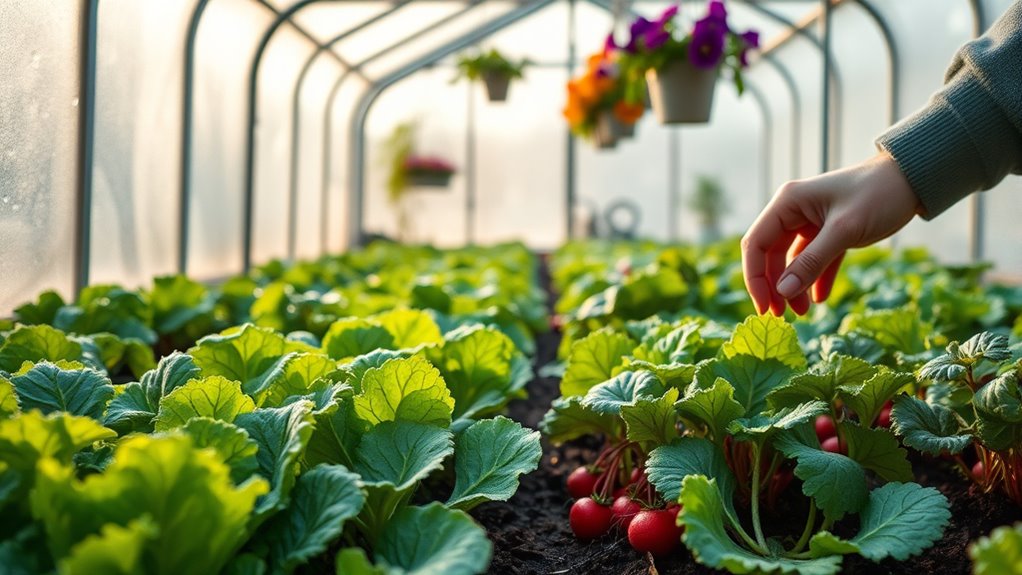
While winter gardening might seem limited, a variety of crops thrive in greenhouse conditions during the colder months.
Leafy greens like kale, spinach, and arugula are perfect choices due to their cold hardiness. Cold-tolerant varieties like Merlo Nero spinach and Riccio d'Asti kale can survive temperatures as low as -6C, making them ideal for your winter garden.
Root vegetables, including carrots and beets, can withstand freezing temperatures, making them ideal for your winter garden.
Brassicas such as broccoli and cabbage also do well if you provide proper care.
Don't forget about alliums like garlic and onions; they're well-suited for winter greenhouses.
For a quick harvest, consider microgreens, which grow rapidly and require minimal space.
Essential Equipment for Winter Greenhouses
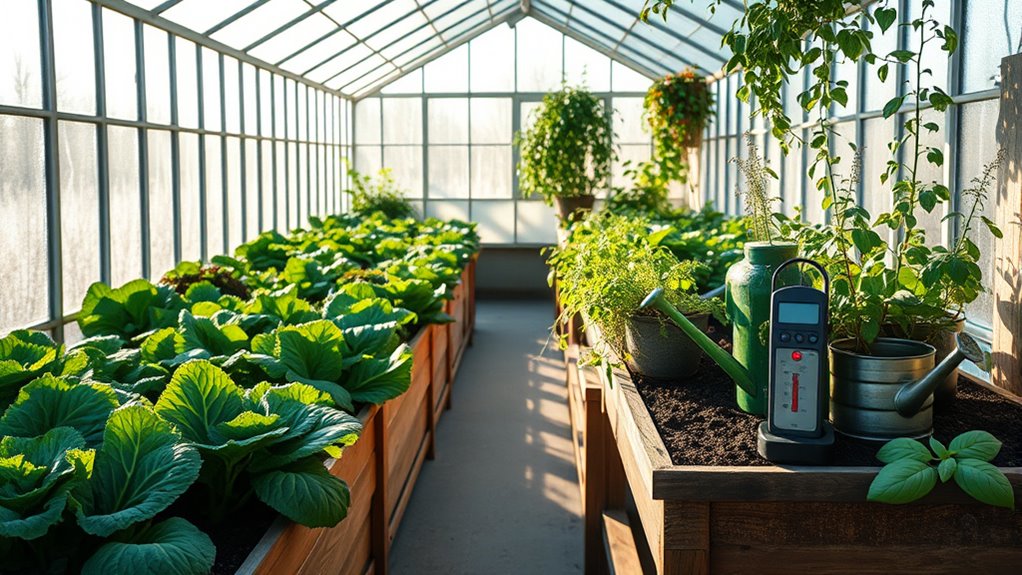
To successfully cultivate crops in a winter greenhouse, you'll need essential equipment that ensures a stable environment for your plants.
Start with durable materials like double-walled polycarbonate or glass for your structure, and choose frames made of metal, wood, or PVC based on your needs. Winter greenhouses are specifically designed to retain heat more effectively than standard hoophouses, making them ideal for winter gardening.
Effective heating is crucial; consider electric or propane heaters along with thermostats for temperature control.
Implement grow lights, preferably energy-efficient LEDs, to provide necessary light during short days.
Don't forget ventilation fans to maintain airflow and prevent overheating.
Lastly, keep your greenhouse insulated with materials like horticultural bubble wrap, and seal any gaps to protect your plants from harsh winter conditions.
Investing in these essentials will set you up for success.
Tips for Successful Winter Greenhouse Gardening
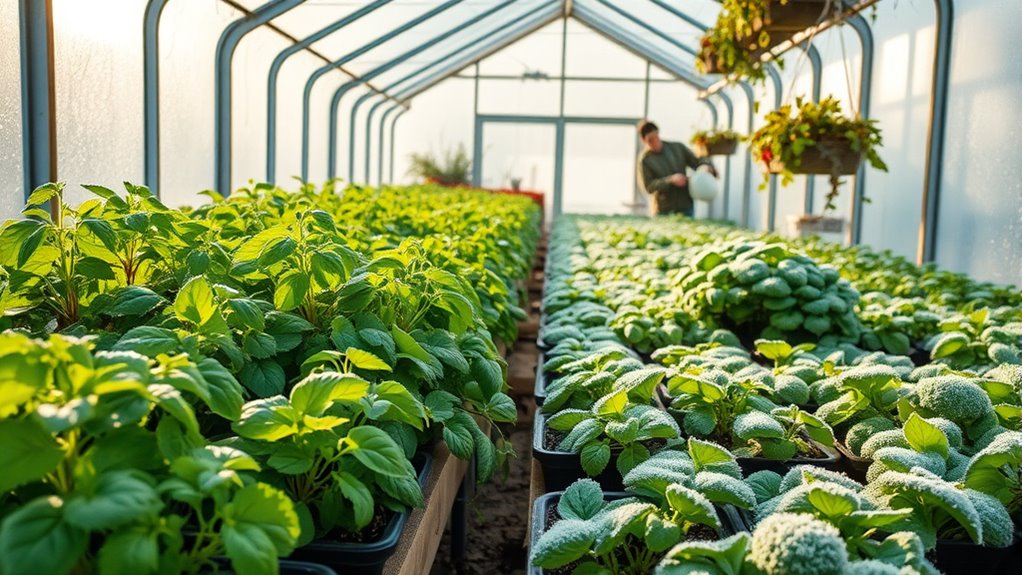
After equipping your winter greenhouse with the right tools, it's time to focus on effective gardening techniques that will help your plants thrive.
Start by managing temperature with water-filled barrels to stabilize heat or by installing heaters for colder climates. Insulate your greenhouse with bubble wrap to retain warmth. Additionally, consider utilizing a heating system to ensure the temperature remains optimal for plant growth.
Optimize light by positioning your greenhouse to capture sunlight and using grow lights to supplement during shorter days.
Water less frequently, monitoring soil moisture to avoid overwatering. Ensure proper ventilation by opening vents regularly to promote airflow and reduce humidity.
Finally, conduct daily inspections for pests and maintain cleanliness to prevent issues. These strategies will create an ideal environment for your winter greenhouse garden.
Common Winter Greenhouse Crops
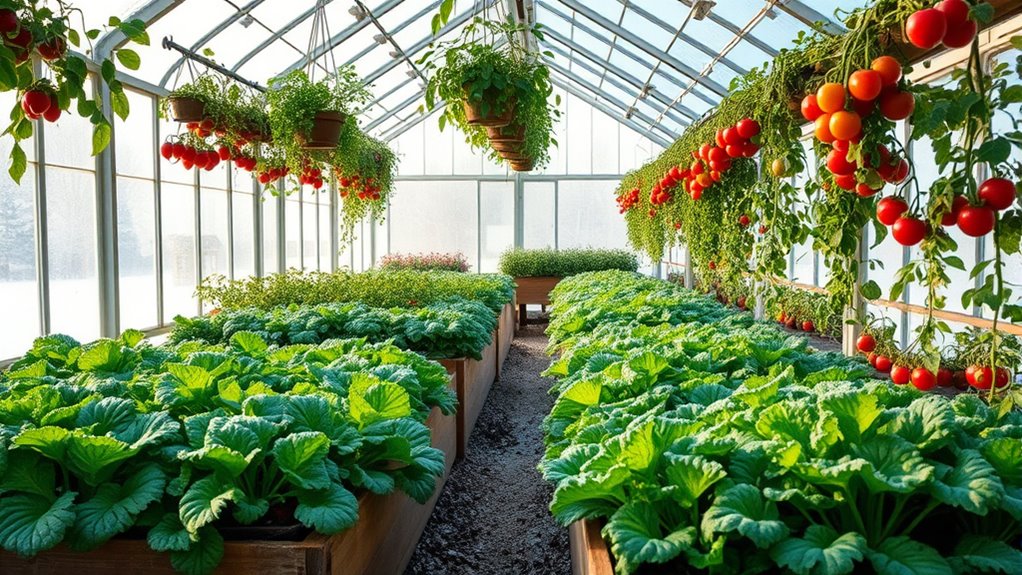
A winter greenhouse can be a treasure trove of fresh produce, offering an array of crops that thrive in cooler temperatures. Leafy greens like kale, spinach, and Swiss chard are excellent cold-tolerant choices. Leafy herbs such as basil, coriander, mint, and dill can be grown and harvested throughout winter. Root vegetables such as carrots, beets, and turnips not only survive but actually sweeten in the cold. Brassicas, including broccoli, cabbage, and Brussels sprouts, flourish with proper care. Don't forget about herbs; parsley, cilantro, and chives do well in chilly conditions. For something quick and easy, microgreens like beets, peas, and spinach can be harvested in no time. With these crops, your winter greenhouse can provide a vibrant and productive growing space, even in the coldest months.
Strategies for Optimizing Winter Greenhouse Conditions
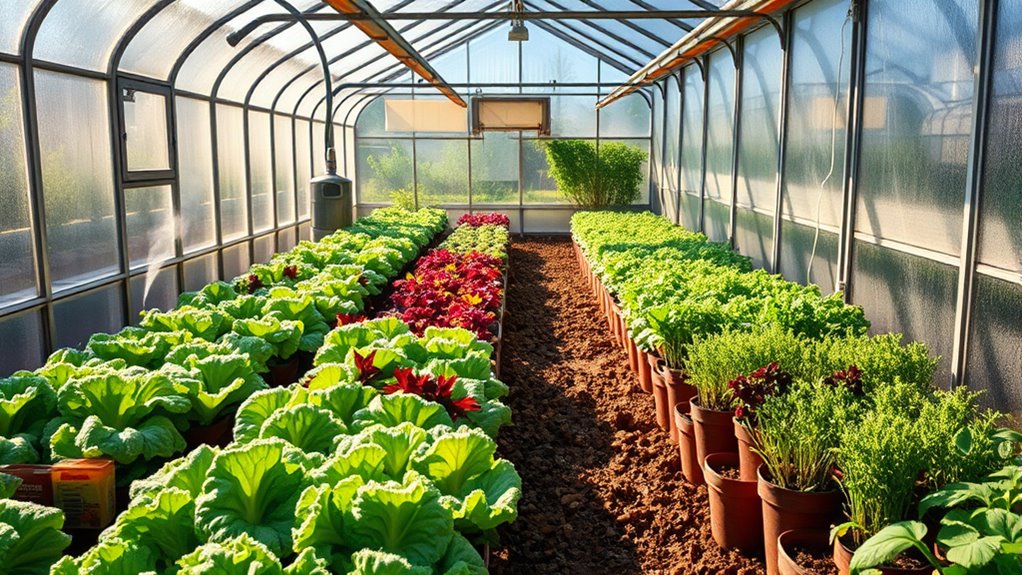
While winter can pose challenges for greenhouse gardening, optimizing conditions within your greenhouse can ensure a thriving environment for your crops.
Start by enhancing insulation with thermal curtains or double-walled polycarbonate to retain heat effectively. Consider using bubble wrap or thermal blankets for extra heat retention, as the insulation capability of the building envelope is crucial in colder climates. Additionally, conducting an energy efficiency evaluation can help identify other areas for improvement.
For energy-efficient heating, geothermal systems and infrared heaters are great options. You can also implement passive heating strategies to complement active systems.
To support plant growth, use energy-efficient LED lighting, ensuring you cover the appropriate light spectrum and adjust your daily light integral.
Finally, automate your greenhouse with controllers and sensors to maintain optimal conditions, reducing labor and allowing you to focus on nurturing your plants.
Managing Temperature and Humidity
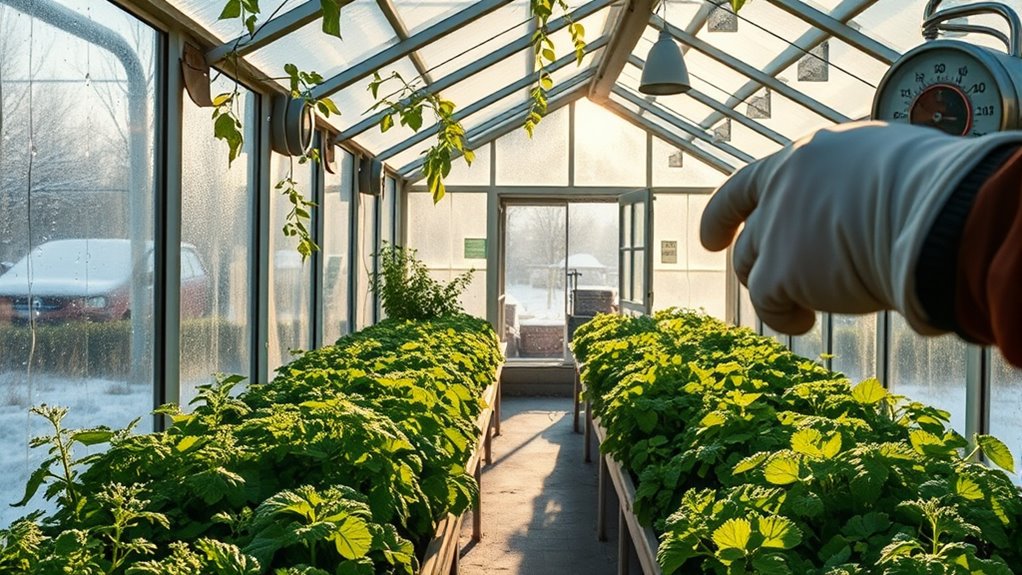
Managing temperature and humidity in your winter greenhouse is crucial for fostering healthy plant growth. Keep your greenhouse between 45°F and 70°F (7°C to 21°C) to ensure optimal conditions. Use electric heaters or propane systems, and consider insulation materials like bubble wrap to minimize heat loss. Additionally, implementing thermal curtain systems can help reduce heat loss at night while maintaining warmth during the day.
Regularly check temperatures with thermometers and use thermostats for efficient control. To manage humidity, increase ventilation by using fans or opening vents, and monitor your watering to avoid excess moisture. Dehumidifiers can help reduce humidity levels.
Soil Quality and Fertilization Techniques
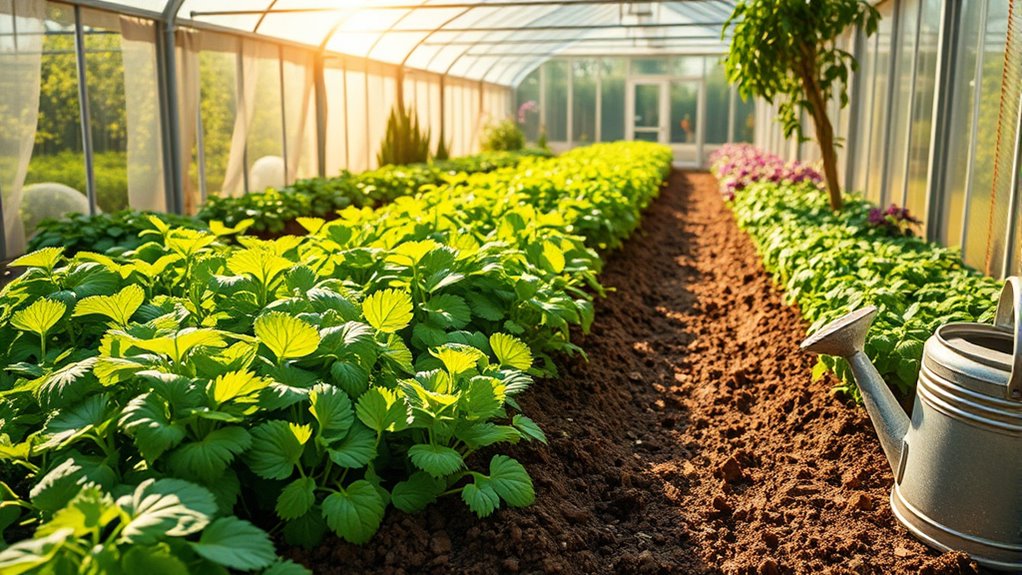
Soil quality is vital for successful winter greenhouse gardening, as it directly impacts plant health and productivity.
Start with loam soil for balanced moisture and fertility, but consider sandy or clay soils, which require extra care and amendments. Regularly test your soil every 2-3 months to monitor pH levels, aiming for a range of 6.0-7.0. Adjust pH using lime or sulfur as needed. Incorporate organic amendments like compost and pelletized manures to boost nutrients and improve soil structure. Liquid fertilizers such as fish emulsion work well for quick nutrient boosts. Don't forget about mycorrhizal fungi, which enhance nutrient uptake and function like probiotics for soil health. Finally, maintain good drainage and moisture to support beneficial microbial life in your greenhouse.
Pest Management in Winter Greenhouses
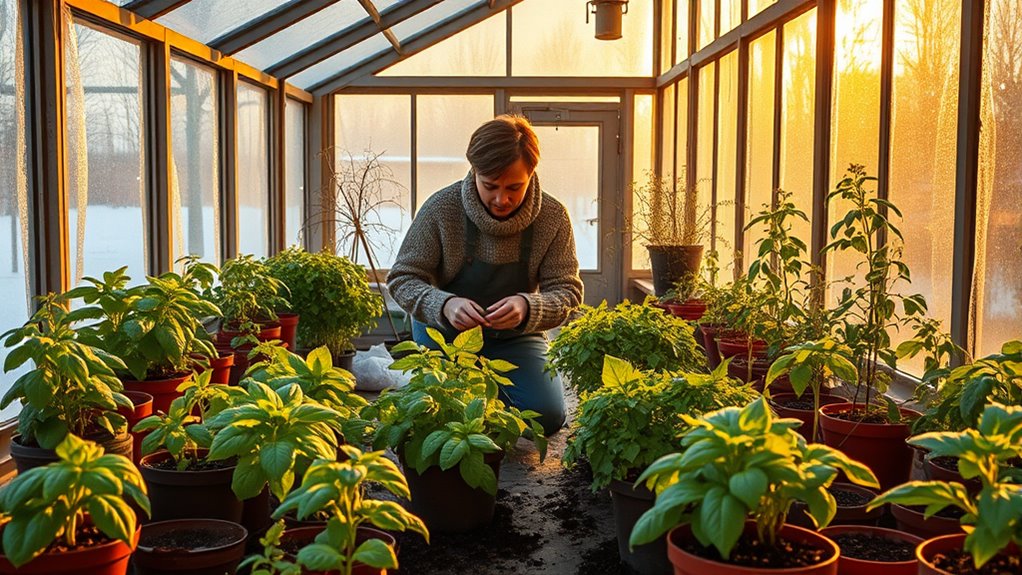
Effective pest management in winter greenhouses is crucial for maintaining healthy plants and maximizing yields.
Start by focusing on prevention; keeping your space clean and debris-free is key. Regularly monitor your plants for pests using yellow sticky traps and pheromone traps. Consider biological control methods, like introducing beneficial insects such as ladybugs and predatory mites to combat pests naturally. Implement cultural practices, like proper ventilation and plant spacing, to discourage pest buildup. Additionally, maintaining a clean house helps prevent pest infestations and supports the overall health of your plants.
If needed, use targeted chemical controls as a last resort, ensuring minimal harm to beneficial organisms. Don't forget physical barriers, such as insect screens and row covers, to further protect your plants.
Harvesting and Utilizing Your Winter Produce
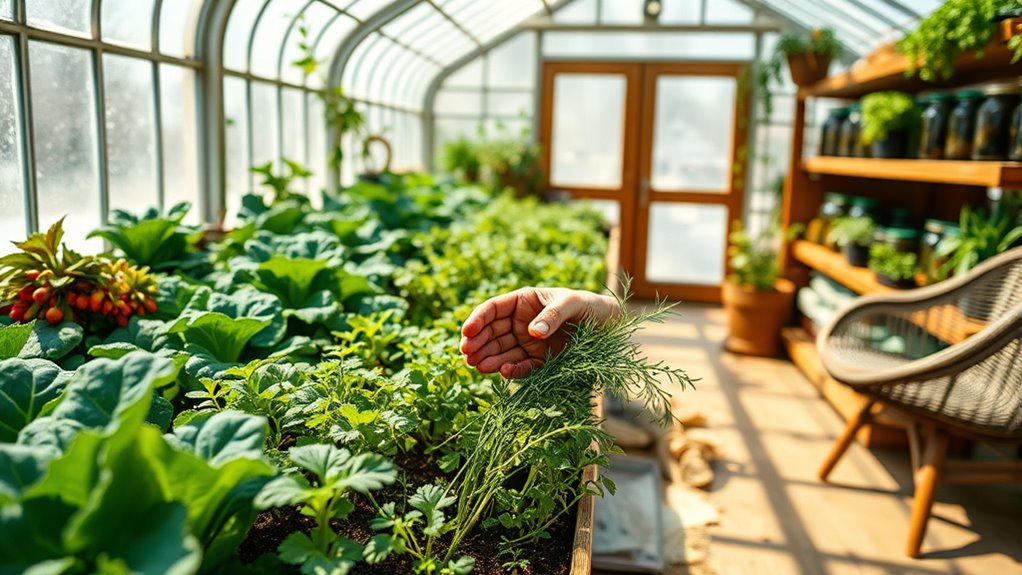
Although winter gardening can be challenging, harvesting and utilizing your winter produce effectively can reward you with fresh, nutritious food throughout the colder months.
To ensure optimal flavor, time your harvest carefully—pick leafy greens when they're young. Use methods like cut-and-come-again for continuous harvests without harming the plant. Sharp, clean tools minimize damage and disease risk. Regular harvesting encourages regrowth and prevents bitterness in veggies. Additionally, many cold-hardy vegetables thrive in cooler temperatures, enhancing eating quality.
Enjoy root vegetables like carrots and beets fresh, or store them in cool, dark places to extend shelf life. Consider preserving excess produce through freezing or pickling.
Incorporate winter crops into hearty soups, fresh salads, or roasted dishes for variety, while sharing or selling excess produce can strengthen community ties.
Frequently Asked Questions
How Do I Choose the Right Location for My Greenhouse?
To choose the right location for your greenhouse, you'll want to consider several factors.
Look for a spot that gets at least six hours of direct sunlight daily and has good drainage.
Assess wind patterns and avoid areas with extreme weather.
Ensure easy access for maintenance and transportation, and think about future expansion.
Lastly, check local regulations to ensure your greenhouse complies with zoning and environmental laws.
What Are the Initial Setup Costs for a Winter Greenhouse?
When you're setting up a winter greenhouse, you'll face several initial costs.
You'll need to consider land acquisition, which could range from $500 to $2,000 monthly for leasing.
The greenhouse structure itself might cost between $5,000 and $30,000, plus climate control systems at $2,000 to $10,000.
Don't forget utility setups, which can add another $2,000 to $5,000.
Can I Grow Flowering Plants in a Winter Greenhouse?
Yes, you can definitely grow flowering plants in a winter greenhouse!
Just make sure you choose the right varieties that thrive in cooler temperatures, like pansies or amaryllis.
You'll need to maintain optimal temperatures and provide adequate lighting since natural sunlight is limited.
Keep an eye on humidity levels and ensure your soil drains well.
With proper care, your greenhouse will burst with color and beauty throughout the winter months.
How Do I Prevent Frost Damage in My Greenhouse?
You might think frost is the enemy of greenhouse gardening, but with the right strategies, you can easily protect your plants.
Start by insulating your greenhouse with bubble wrap or horticultural fleece to trap warmth. Consider using electric heaters or soil-warming cables to maintain a cozy environment.
Regularly monitor temperature and humidity levels, and don't forget to ventilate to prevent overheating.
With these methods, you'll keep your plants safe from frost damage effectively.
What Is the Best Time to Start Planting for Winter Harvests?
The best time to start planting for winter harvests is in August or September. This timing lets your crops mature before the days get too short.
Focus on cool-season crops like kale, spinach, and root vegetables such as carrots and beets. Keep an eye on your local climate; ideally, you want to plant when nighttime temperatures stay above 45°F.
Proper planning ensures you'll enjoy a successful winter harvest!
Conclusion
As you step into your winter greenhouse, imagine it as a hidden sanctuary, bursting with life amid the frosty landscape outside. With the right crops and care, you'll cultivate not just plants, but a vibrant patch of summer in the heart of winter. Embrace the warmth, nurture your greens, and savor the rich flavors of your harvest. This winter gardening adventure will transform each chilly day into a celebration of growth and resilience, proving that even in the cold, life thrives.
